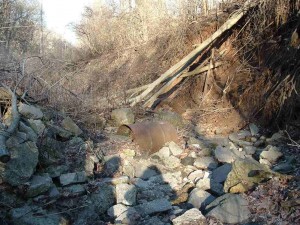 Lake Wingra water quality is severely degraded by nutrient-containing soils and sediment that enter the Lake via the City of Madison storm water drains. Three storm drains discharge into Lake Wingra at the Ho-Nee-Um Pond and near the Wingra Park boat house (aerial photo: Ho-Nee-Um Pond Storm Sewers). Storm water entering the lake at these outfalls is untreated; consequently, deposition of street sand and large particles has created “islands” in Lake Wingra and Ho-Nee-Um Pond and is causing the Wingra Park Marina to fill with sediment. The nutrients associated with storm water discharge have led to increased aquatic weed growth and algal blooms.
Lake Wingra water quality is severely degraded by nutrient-containing soils and sediment that enter the Lake via the City of Madison storm water drains. Three storm drains discharge into Lake Wingra at the Ho-Nee-Um Pond and near the Wingra Park boat house (aerial photo: Ho-Nee-Um Pond Storm Sewers). Storm water entering the lake at these outfalls is untreated; consequently, deposition of street sand and large particles has created “islands” in Lake Wingra and Ho-Nee-Um Pond and is causing the Wingra Park Marina to fill with sediment. The nutrients associated with storm water discharge have led to increased aquatic weed growth and algal blooms.
In addition to street sand, severe erosion of storm water channels along the Southwest Bike Path (see photo) and drainage from Glenway Golf Course has discharged thousands of cubic meters of suspended solids into Lake Wingra.
Virtually every invasive species growing in the watershed has a strong foothold along the bike path. Seeds of these invasive plant species can be transported by overland storm water flows toward the lake. Storm water itself disturbs natural communities and creates openings for invasive species. The nutrients and sediment loads carried by storm water further create conditions that are favorable for invasive plant species.
The SW Bike Path Restoration project seeks to reverse this situation by restoring an eroding watercourse that drains into Lake Wingra at Wingra Park. Project goals support management values described in the Friends of Lake Wingra management plans for storm water and invasive species.
Improve storm water management practices in the watershed
Immediate steps should be made to: a) eliminate erosion caused by overland storm water flow; b) decrease overland flows and increase infiltration of rainfall where it falls; and c) improve the management of impervious surfaces to capture nutrients and sediment before they flow into Lake Wingra, and d) repair existing storm water detention facilities (FOLW Storm Water Management Plan, 2003).
Native habitat restoration
Improve natural habit through increased planting of native species, restoration of degraded lands and reversal of damage and ecosystem system alteration caused by storm water and invasive species.
Develop a pilot neighborhood project for improved management of storm water, control of invasive plant species and restoration of native habitat in a community public space
Provide assistance in developing community plans for control of invasive species, restoration and management. Neighborhood segments along the SW Bike Pedestrian Path corridor provide numerous opportunities for such projects (FOLW Invasive Species Management Plan, 2003).
Specific possible actions to achieve these goals:
- Control up-gradient erosion to prevent continued sediment transport to the lake.
- Sub-surface infiltration of storm water at Glenway Golf Course has been suggested.
- Restore and enhance the golf course woods to reduce erosion and increase infiltration.
- Provide for increased infiltration of rainfall at Forest Hills Cemetery through porous pavement and turf management.
- Begin to control some of the serious invasive plants such as garlic mustard and Japanese knotweed.
- Develop pilot restoration and vegetation management plans for a segment of the bike path.
The Friends of Lake Wingra (FOLW) has received start-up funding from the Therese Foundation for a project that will include the Friends of the SW Bikepath, Dudgeon-Monroe neighborhood, the City of Madison Parks and Storm Water Utility, and the UW-Arboretum.
Get Involved!
If you would like to get involved in combating invasive plants and storm water erosion along the bike path, contact Friends of Lake Wingra at info@lakewingra.org. Also, attend some of our upcoming events listed on the calendar and get acquainted with the watershed by walking or biking along the path. We’ll be hosting work parties to get community input on our pilot restoration project — stay tuned!
